Micromobility is here to stay, and it’s changing how we experience urban life for the better. With Unagi’s membership program, you can enjoy all the benefits of a top-tier electric scooter without the sky-high price of ownership or the inconvenience of ride-sharing.
Ready to ride the revolution? Electric scooters in Washington, D.C. are transforming the way we explore the city, combining convenience, fun, and a touch of eco-friendly flair. These lightweight electric scooters are your ticket to zipping through traffic, uncovering scenic routes, and experiencing the 150 miles of bike lanes and trails D.C. has to offer, like never before.
But before you hit the streets, there are a few things you need to know. From the ins and outs of local laws to the most picturesque paths and essential riding tips, this guide has it all.
This comprehensive article will cover these laws, offer recommendations for acquiring an electric scooter within the district, suggest scenic routes for enjoyable rides, and provide tips to enhance your scooter ownership and riding experience in D.C.
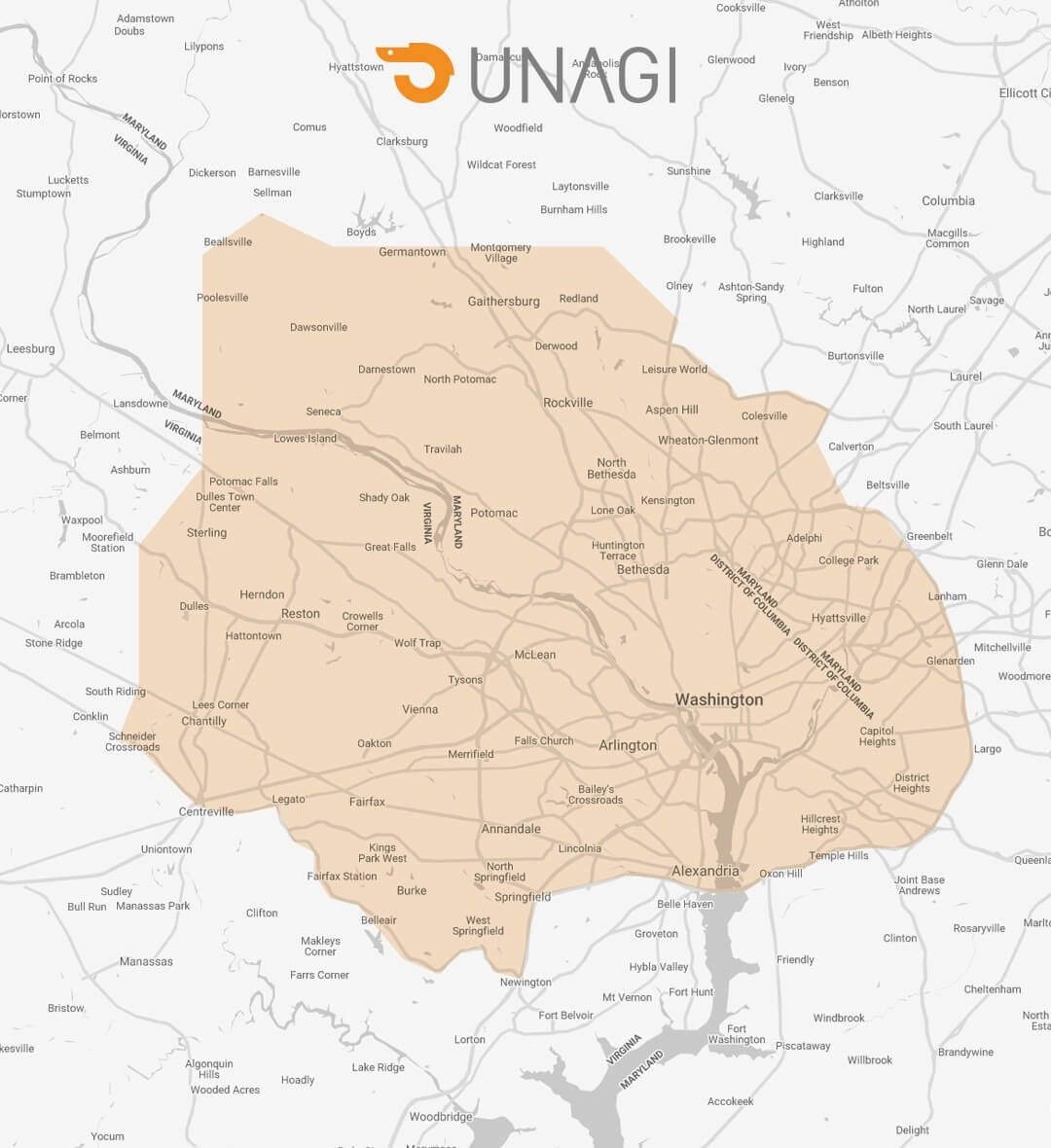
Are electric scooters allowed in Washington, DC?
Yes, they are legal in the district, with over 28 million trips recorded in the city since 2019 by the District Department of Transportation. However, it's not a free-for-all; specific regulations are in place to ensure the safety of both electric scooter riders and other road users.
According to DC law, electric scooters are governed under the broader category of “Personal Mobility Devices” (PMDs), which includes heavier motorized devices and self-balancing devices with various propulsion systems, not just electric. They can also fall under the more specific category of “Electric Mobility Devices” (EMDs), which provides a near-exact description of electric scooters but limits the weight of the devices to below 75 lbs and requires that they be propelled by an electric motor.
Fortunately, the laws governing PMDs and EMDs are similar in most cases, so there is not much conflict between them. Combining both sets of regulations gives a comprehensive overview of the rules for electric scooters.
Preview of Washington, D.C., electric scooter laws
Here's a skeleton breakdown of the laws, which we will discuss in detail in the proceeding sections.
Rider requirements:
- No license required
- Age requirement: Users must be at least 16.
- Helmet use: Required for users under 16.
Riding rules:
- Yield to pedestrians.
- Ride in bike lanes when available, on sidewalks, and low-speed roads.
- Riding on sidewalks is prohibited in the Central Business District and certain areas of the National Mall.
- Users must not exceed the maximum speed limit set by the Director, which is 10 mph.
Parking:
- Devices must be parked upright.
- Must lock the scooter to approved city infrastructure
- Park in designated bike racks and corrals when available.
- On the furniture zone, ensure at least 5 feet of unobstructed pedestrian walkway.
Additional rules:
Operating restrictions:
- No passengers allowed.
- No riding the scooter while intoxicated.
- No carrying items that hinder keeping both hands on the handlebars.
- No headsets or earphones: Except for hearing aids or one-ear devices.
Here's an easy infographic that summarizes these rules in an easy-to-remember format.
What is considered an electric scooter in D.C.?
Electric scooters can fall under two legal categories: "Personal Mobility Devices" (PMDs) and "Electric Mobility Devices" (EMDs). While the PMD category is more inclusive and may encompass a variety of mobility devices, the EMD category is more specific and primarily refers to electric scooters. Understanding the distinction between these two can help you determine how your scooter is classified under DC law.
A "Personal Mobility Device," or "PMD," is defined as a motorized propulsion device designed to transport only one person that either:
- Weighs 75 pounds or more, or
- Is a self-balancing, two-non-tandem wheeled device.
On the other hand, an "Electric Mobility Device" or "EMD" is defined as a device weighing less than 75 pounds that:
- Has an electric motor.
- Is solely powered by the electric motor or human power.
- Is designed to transport only one person in a standing or seated position, where the rider is not enclosed.
- Is no greater than 24 inches wide and 55 inches long.
Key differences:
Weight: An EMD weighs less than 75 pounds, while a PMD weighs 75 pounds or more.
Power source: EMDs are powered by an electric motor or human power. PMDs can have various types of motorized propulsion, not limited to electric motors.
Design features: PMDs are one-person vehicles that may include a variety of mobility devices. Electric mobility scooters are designed to transport a person in a standing or seated position without being enclosed, with specific size restrictions (no greater than 24 inches wide and 55 inches long).
Based on these features and dimensions, you can categorize your scooter as either an EMD or a PMD.
Additional safety and equipment requirements:
- Lighting: If you plan to ride at night, your e-scooter must have a front light and a rear reflector for visibility.
- Bell: For safety and alerting others, your scooter must have a bell.
- Speed limiter: Your electric scooter should not exceed a speed of 10 mph in public spaces. Ensure your scooter has a limiter to keep this in check.
What is the speed limit on electric scooters in Washington D.C.?
Personal mobility vehicles, which include electric scooters, are restricted to a maximum speed of 10 mph, which is one of the lowest speed limits for e-scooters in the United States.
Do you need a license to ride an e-scooter in D.C.?
Nope, you don’t need a license to ride your personal e-scooter in D.C. However, some shared scooter companies, like Lyft, might require you to have a valid driver's license or ID card, which you’ll need to upload before you start your ride.
Minimum age requirement for riding e-scooters in Washington, D.C.
The legal age to ride an electric scooter in D.C. is 16. However, scooter-sharing companies have the authority to bump that, with most requiring you to be at least 18 years old to ride.
Do you have to wear a helmet?
Riders under the age of 16 are required to wear a helmet when operating a scooter. Parents or guardians are on the hook for making sure they’re geared up. Skip the helmet, and you’re looking at a $25 fine. First-time offenders or those who buy a compliant helmet after the ticket can get that fine waived if they show proof of purchase (before the fine is due).

For more information on helmet options, check out our article on the best electric scooter helmets.
Can you carry a passenger or items on an electric scooter in Washington D.C.?
Nope, it’s illegal to carry a passenger on your electric scooter or haul goods that stop you from keeping both hands on the handlebars. If you need to carry items, consider using a backpack or, even better, get yourself an electric scooter built for carrying cargo. For some killer recommendations, dive into our article on the best electric scooters for carrying stuff.
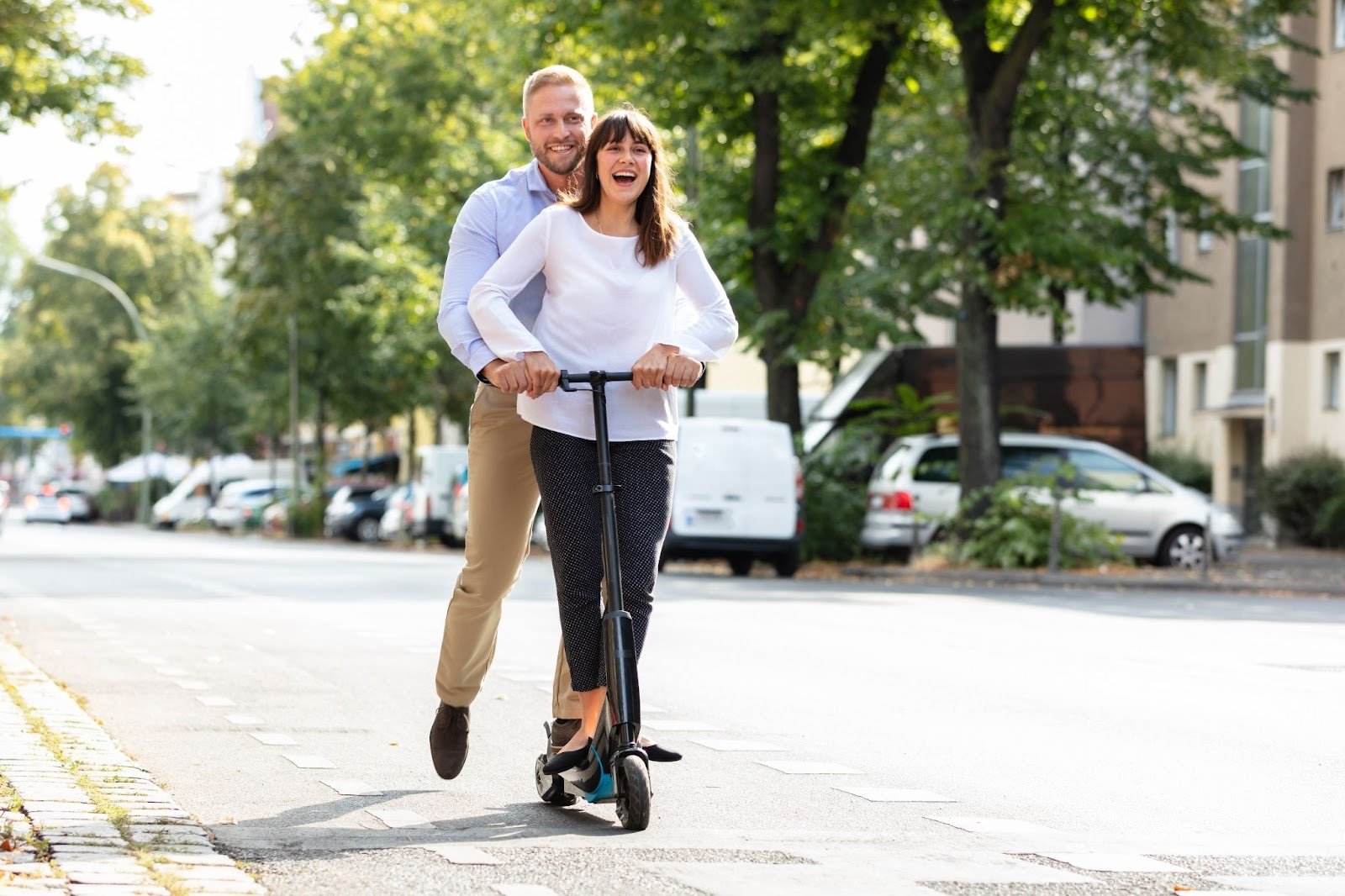
Can you get a DUI charge when riding an e-scooter in Washington, D.C.?
You bet. It’s illegal to ride an electric scooter under the influence of alcohol or drugs in D.C. If you get caught scooting while tipsy, you could face fines up to $150 upon conviction. So, keep the party off the handlebars.
Do you need insurance or registration for your electric scooter in Washington, D.C.?
As of now, you don't need insurance for your electric scooter, and there's no need to register it with the DMV like you would with other motor vehicles. However, the mayor has the authority to change things up and establish a registration process, which could require electric scooters to have a serial number, valid registration tag, or registration plate.
Where can you legally ride electric scooters in Washington D.C.?
You can legally ride electric scooters in the following areas:
- Bike lanes (primary and most appropriate place): Ride with traffic in a single file.
- Streets and low-speed roadways.
- Bus lanes
- Shared lanes (sharrows)
- Off-street trails designated for scooters
- Sidewalks except within the Central Business District (Downtown).
Where are electric scooters prohibited in Washington D.C.?
D.C. might be pretty chill with e-scooters, but there are a few spots where you need to keep those wheels off the ground:
- Sidewalks in the Central Business District (CBD)
- Certain areas of the National Mall, particularly around the following memorials and parks: Lincoln Memorial, Vietnam Veterans Memorial, Korean War Veterans Memorial, World War I and II Memorial, Martin Luther King Jr. Memorial, Franklin Delano Roosevelt Memorial, Thomas Jefferson Memorial, Washington Monument, Benjamin Banneker Park, and the Justice Square Metro Station area
These zones are marked in red on maps and are geofenced for shared scooters, meaning they’ll automatically shut down if you ride into these areas. The zones are heavily trafficked by pedestrians and hold significant historical, cultural, or administrative importance.
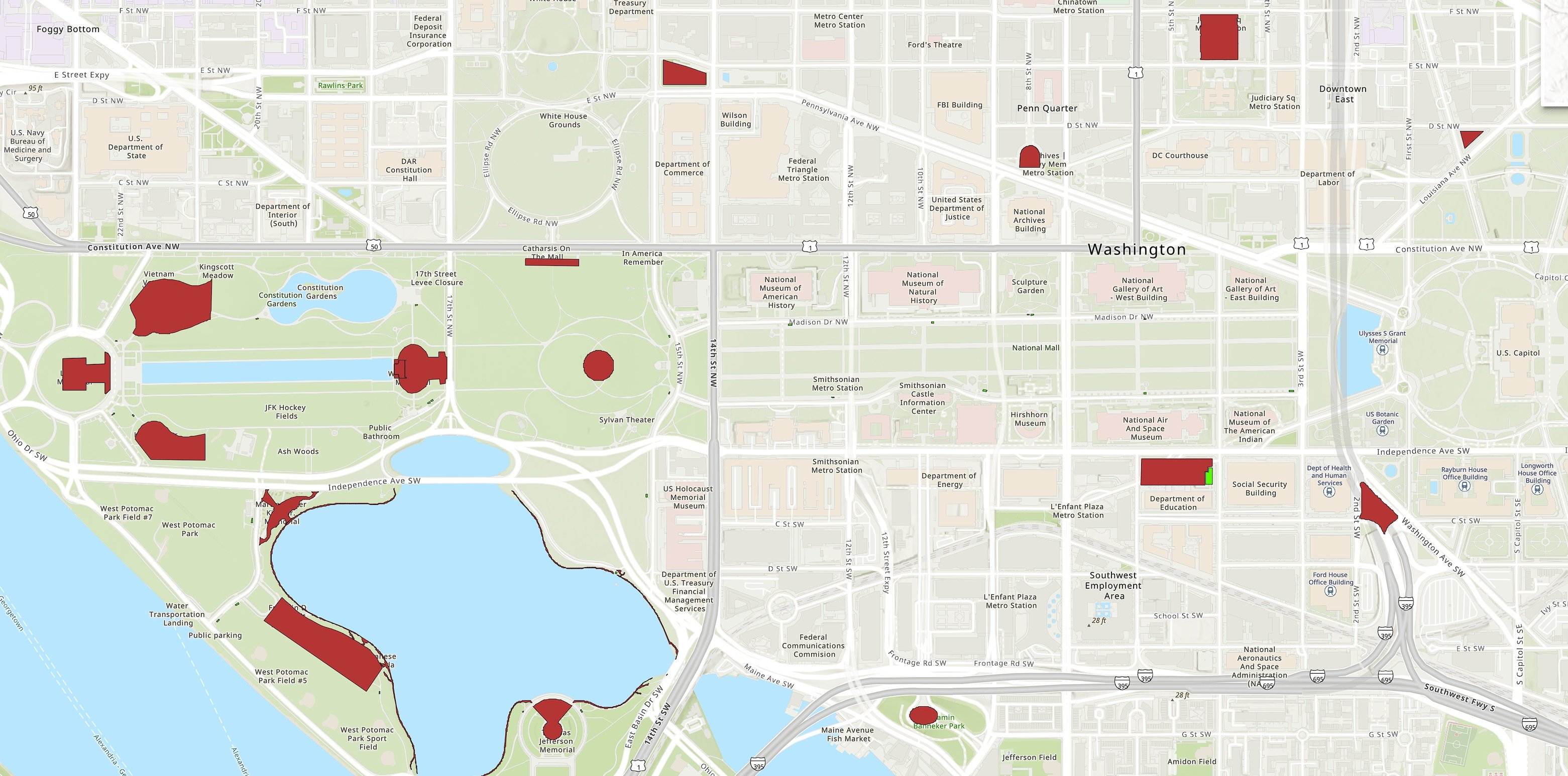
The restrictions help maintain the decorum of these spaces and ensure the safety of visitors and workers in the area. However, you can still ride scooters on sidewalks and roads outside of the designated memorial areas.
Can you ride electric scooters on sidewalks in Washington D.C.?
Yes, you can ride on most sidewalks in Washington D.C., with the exception of the Central Business District and other locations where signs are posted prohibiting it. The CBD, which covers downtown and the U.S. Capitol grounds, is defined as the area enclosed by:
- North Boundary: Massachusetts Avenue (Mass Ave)
- South Boundary: D Street SW/SE
- West Boundary: 23rd Street NW
- East Boundary: 2nd Street NE
- Exclusion: The Mall west of 14th Street is not included
Riding your scooter on CBD sidewalks can get you a $25 fine.
In areas where sidewalk-riding is allowed, always remember to yield to pedestrians, as they have the right of way. If you collide with a pedestrian in these areas, you could face a fine of up to $250, 30 days imprisonment, or both.
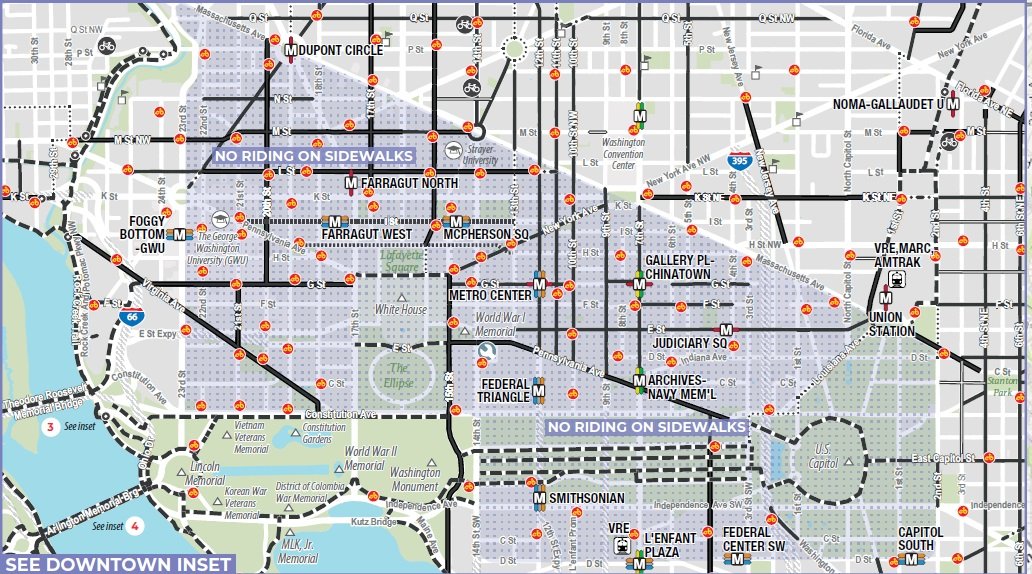
Can you ride an electric scooter on the road in Washington, D.C.?
Yes, you can ride e-scooters on most low-speed roads in Washington, D.C. However, they are not allowed on interstates. When riding on the road, you have all the general rights and duties of vehicle drivers, which means you need to follow traffic laws, such as indicating when you're turning, stopping at red lights, and so on.
While it is sometimes advisable to take your own lane on the road to improve visibility and reduce the risk of cars swiping you or squeezing you into the curb, the low-speed limit of 10 mph placed on electric scooters makes this impractical. Going that slow in the middle of a lane is going to hold up traffic, which isn’t just annoying for drivers, it's illegal. Therefore, you should move to the right side of the road as safely as possible and avoid hazards like parked cars, pavement irregularities, and other obstacles.
As long as e-scooters are restricted to 10 mph, riding them on the road will always feel a bit dicey. Traffic often moves much faster, making you feel like a target, and if something goes wrong, the consequences can be severe. The slow speed limit might eventually push you to ride on the sidewalk, but even there, 10 mph can be too fast and unsafe for pedestrians. Your best bet is just to stick to protected bike lanes.
Where should you park your electric scooter in Washington D.C.?
First things first, make sure your e-scooter is parked in an upright position. It's neat, takes up less space, and minimizes the risk of someone tripping over it.
As for where to park, D.C. has some specific rules. Scooter riders are required to park and lock shared electric scooters to designated city infrastructure after use. This includes the over 1,000 bike racks installed in the city, in-street corrals, scooter docks provided by operators, or other marked zones for scooter parking.
Besides bike racks and corrals, it’s also cool to lock your scooter to parking signposts, stop signs, or parking meters, as long as it doesn’t block pedestrian pathways. Shared scooter companies are responsible for providing the locking mechanisms and instructions for riders to use them responsibly.
If designated spots are full, you can park your electric scooter in the furniture zone of the sidewalk (where one exists). Just make sure to leave at least 5 feet of space for pedestrians to pass. And, of course, to lock your electric scooter securely as per the law.
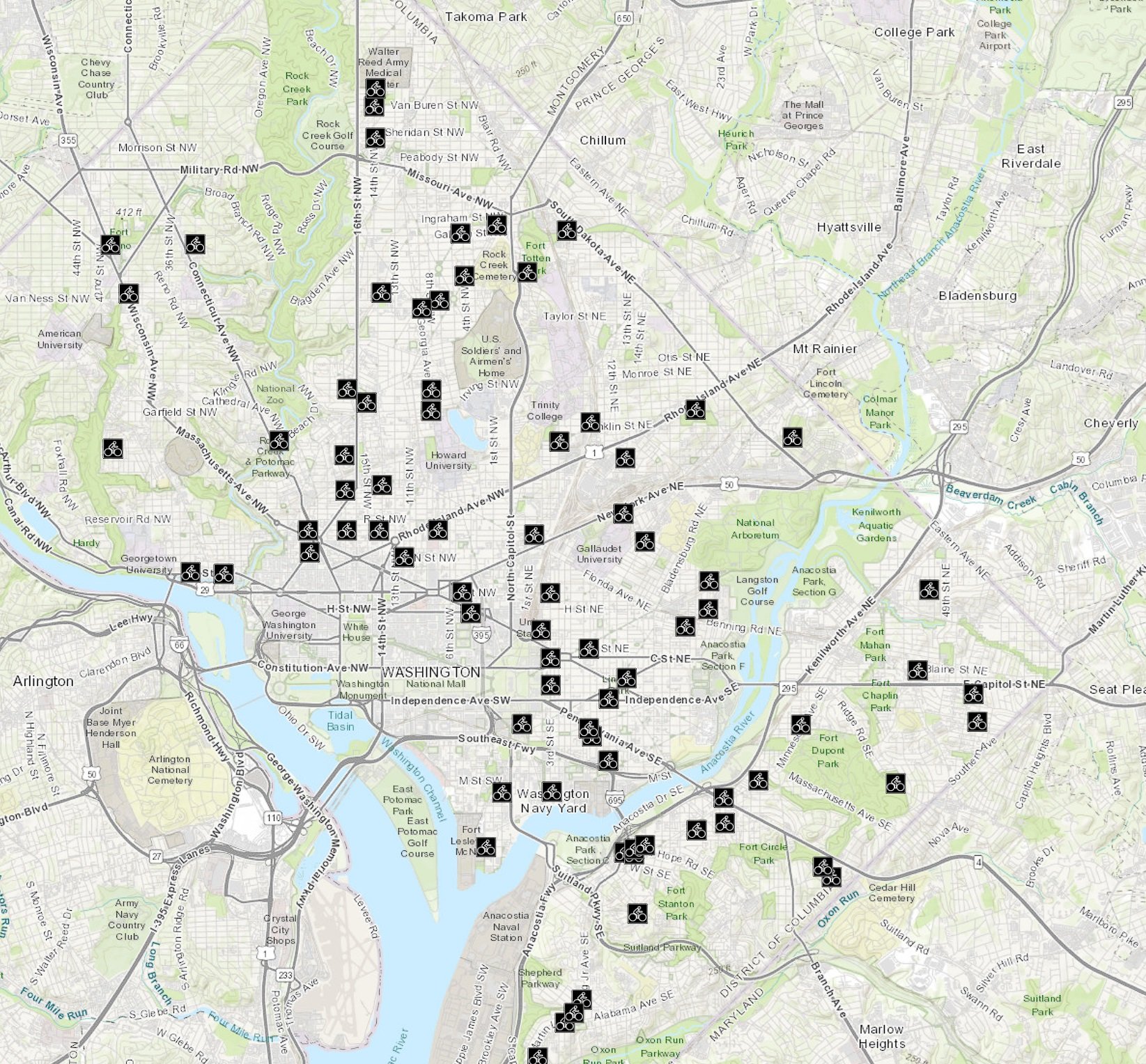
Don’t stress too much about finding a spot, though. D.C. has plenty of off-street parking corral options, as shown in the image above, so it’s rare to miss a spot.

Private scooters can also be parked in these areas, but it’s better to walk around with your electric scooter rather than leave it outside, even for a brief moment, to avoid theft and any disturbance as people might mistake it for a shared scooter. Investing in an electric scooter satchel can make carrying it around a breeze.
Areas to avoid parking your electric scooter
The general rule everywhere is to avoid parking your electric scooter in a way that affects the movement of any traffic (pedestrians, cyclists, or cars) or obstructs emergency routes and infrastructure. It's the same here in D.C.; avoid parking your electric scooter:
- Near public monuments, memorials, and historical landmarks to maintain the area's aesthetic and ensure unobstructed access for visitors.
- Public transportation stops: Avoid parking at Metrobus stops, Capital Bikeshare stations, Circulator stops, and DC Streetcar shelters. These spots need to be clear for passengers.
- On private property without permission, including residential driveways, business entrances, and fenced areas.
Additionally, don’t park in a manner that:
- Impedes pedestrian movement on sidewalks or vehicular travel areas.
- Blocks building entrances, exits, or emergency exits.
- Obstructs handicap ramps or pathways.
When it comes to locking your electric scooter, avoid securing it to:
- Private fences or gates
- Trees
- Capital Bikeshare docks (reserved exclusively for Capital Bikeshare bicycles)
- Garbage cans
- Bus shelters
How to access the electric scooters
There are several convenient ways to access electric scooters in Washington, D.C., including:
Electric scooter rentals in Washington, D.C.
There are thousands of electric scooters available for rent throughout Washington, D.C., provided by four main DDOT-approved companies: Lime, Lyft, Spin, and Veo. The exact number of scooters varies, but there are more than 8,000 dockless vehicles available across all eight wards in the District, particularly in high-traffic areas such as downtown, near Metro stations, and in popular neighborhoods. Lime and Spin hold the largest share of scooters in the pool, so most of the scooters you see around will likely be theirs.
These rental scooters are easily accessible through mobile apps with pay-as-you-go pricing and are available in various locations across the city, making them ideal for one-time, short trips, and first- or last-mile connectivity.
The catch? Each company has its own app, which means you'll need to download a bunch of different ones and create multiple accounts. It's a bit of a hassle, but having all the apps increases your pool and chances of finding an e-scooter when you need one. Also, due to their popularity, it’s best to reserve scooters ahead of time directly in the provider’s app.
The best thing about rental scooters is that you don’t have to worry about maintenance. The companies handle all the upkeep and repairs, so you just hop on and go. They’re also equipped with speed limiters to keep you within legal limits and are geofenced to alert you when you’re in restricted areas, helping you stay on the right side of the law.
They, however, have limited range, making them only great for short trips. Always check the battery life before starting your trip to make sure it’ll get you to your destination.
Occasionally, you may also encounter scooters that haven't been well-maintained. Shared scooters are used by multiple riders throughout the day, some of whom may not treat them with the same care as personal vehicles, causing more frequent damage and significant wear and tear. The scooters are also exposed to various weather conditions, including rain and extreme temperatures, which exacerbates the issue. While companies strive to keep their fleets operational, the large number of scooters makes it logistically challenging to regularly check and maintain each one.
So before anything, give the brakes and overall functionality a quick test before heading off to ensure they are working properly, avoiding any surprises. And let’s not forget the hygiene factor. Shared scooters can get pretty grimy, so keep some sanitizer or wipes handy to clean the handlebars before you ride.
How to rent an e-scooter in Washington, D.C.
- Download the app for your chosen scooter company and create an account.
- Find a scooter: Depending on where you are, this could be as simple as walking down the street until you come upon one. However, using the app, you can see exactly where the scooters are located. The app will show you the location and battery status of each scooter. Be sure to check the range level on a given scooter. If it's not enough to reach your destination, you can pick another scooter even if it's further away, and reserve it, typically for around 10 minutes before you arrive.
- Unlock the scooter: Once you get to your scooter, look for a QR code, probably on the top or somewhere on the front. Click on the "Scan" button in the app, which will open up your phone's camera app to scan the QR code on the actual scooter. Once you've done that, depending on the company, the scooter will either play a sound or the app will give you a notification to confirm that your ride has started.
- Ride the scooter
- End your ride: Park and lock the scooter in a designated area or a place where it does not obstruct pedestrian pathways. You will be required to take a photo of the parked scooter to end your ride. Tap the button to finish your ride. The scooter will probably play a sound confirming that the trip is done.
How much does it cost to rent electric scooters in Washington DC?
Generally, you'll pay an unlock fee and a per-minute usage fee. The unlock fee is usually $1, and the usage fee ranges from $0.25 to $0.35 per minute, depending on the company. Eligible D.C. residents can apply for discounted fares.
Electric scooter subscription in Washington, D.C.
So, if you need a little more convenience than rental scooters, like having a scooter 100% available whenever you need it without the hefty upfront cost of buying one, subscription services might be your jam. It’s also a fantastic way to test out electric scooters for your commutes long-term if you’re not fully sold on the whole idea yet.
Subscription services let you pay for a monthly or annual plan, giving you access to your own personal electric scooter for the duration of your subscription. UNAGI has rolled out such a service in D.C., offering their premium electric scooters. Sign up on the UNAGI website, and once subscribed, your UNAGI scooter gets delivered directly to your doorstep free of charge within 72 hours. The subscription plans start at $59 per month for access to the lightweight UNAGI Model One electric scooter, and at $79 per month, you get the upgraded UNAGI Voyager lightest electric scooter.
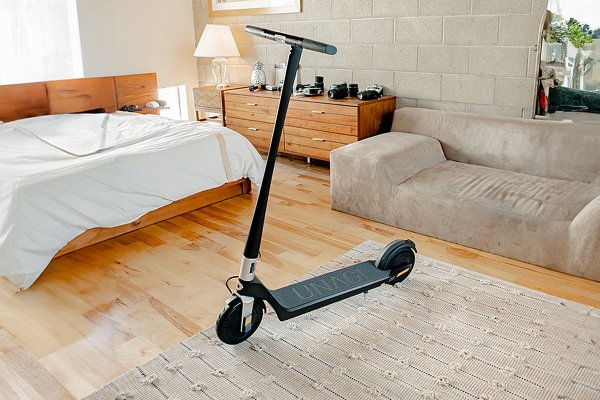
These high-quality scooters provide a superior riding experience compared to typical rental models. Both weigh less than 30 lbs and have a one-click folding system, making them easy to carry around—whether to the office or even onto a bus for intermodal transportation. Perfect commute buddies right there.
When it comes to performance, these dual-motor scooters with puncture-proof tires can handle hills and hit speeds of up to 20 mph, which you can dial down to the city’s 10 mph limit via the app. They’re powered by high-quality LG batteries, offering 12-25 miles of range depending on your riding style, which is plenty for most daily commutes. Even if you run out of juice, the 3-4 hour charging time gets you back on the road in no time. Unlike rentals, your UNAGI scooter is always charged and ready to go, eliminating the hassle of searching for available scooters or dealing with dead batteries.
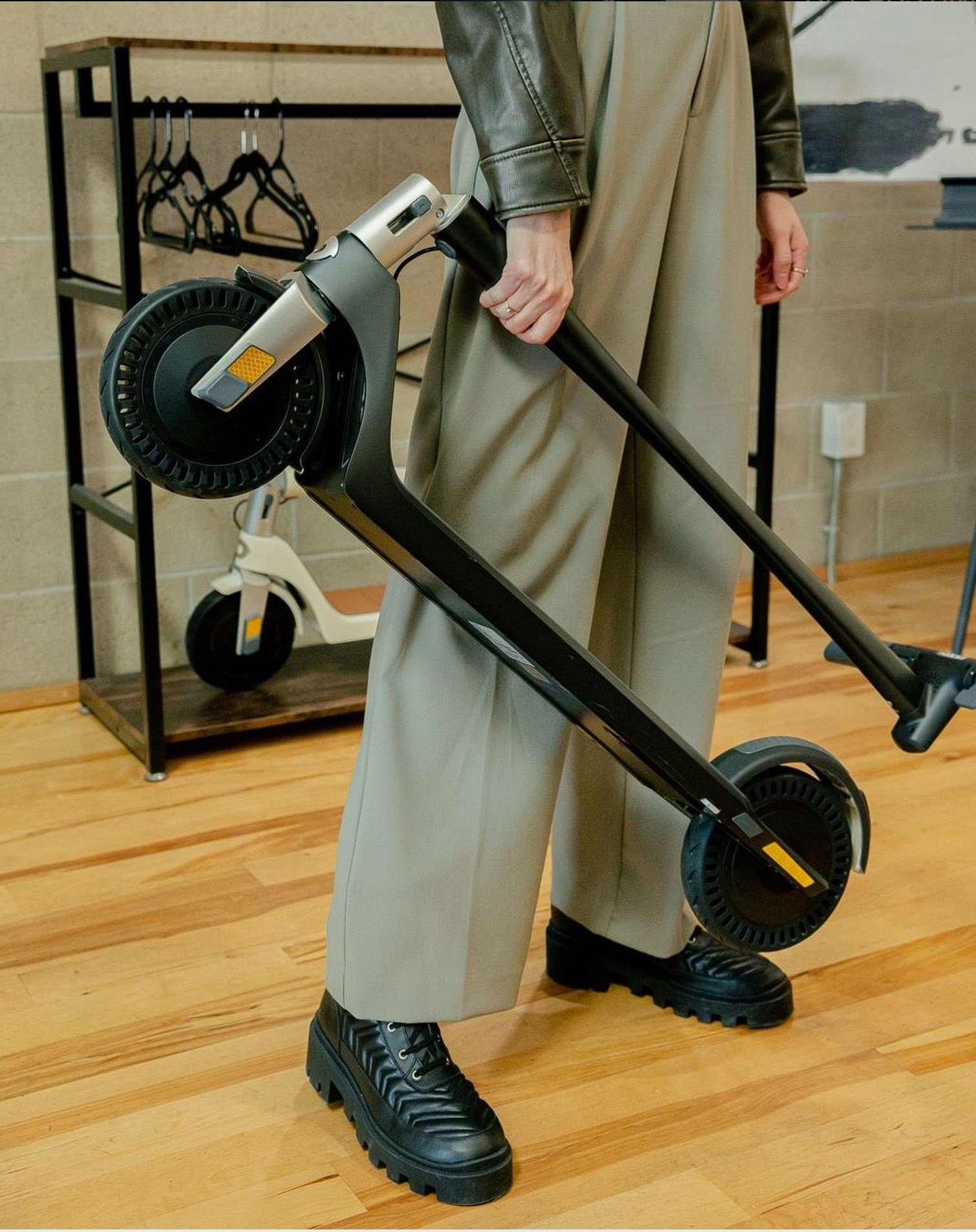
The subscription includes unlimited rides, home delivery, maintenance, and repairs, so you never have to worry about breakdowns or malfunctions. It also comes with comprehensive insurance for theft or damage, giving you peace of mind. The subscription can be paused or canceled at any time, providing flexibility for users who might not need the scooter year-round.

As a bonus, you get to join the exclusive Unagi Community, which hosts cool activities, community events, exclusive offers, and a platform to share experiences with other UNAGI scooter riders. The company also organizes monthly group rides in the area, offering excellent networking opportunities and a chance to explore new places together. Check out the comprehensive yearly calendar for upcoming events.
Buying an electric scooter in Washington, D.C.
If you’ve got the cash to dish out for a new scooter and you’re set on using electric scooters for most of your travels, buying one might be a solid option. While the initial investment is higher, buying a scooter can save you money in the long run compared to renting.
D.C. doesn’t have as many brick-and-mortar stores for electric scooters as cities like New York or San Francisco, but there are still a few spots worth checking out. College Scooters is a good place to start, and they might have a decent selection of electric scooters to choose from. You could also check out big-box stores like Costco or Best Buy; they sometimes stock basic entry-level electric scooters, which might be worth your attention.
For a broader selection and potentially better deals, shopping online is the way to go. You’ll find a variety of models with detailed specs and customer reviews to help you make an informed decision.
In addition to the subscription service mentioned earlier, Unagi also sells its scooters. If you prefer to own one, check out their premium models, the Unagi Model One and the Voyager available for sale on the website.
Before making a purchase, check out our article on electric scooter buying tips for adults to get a perspective on the important features you should consider.
Scenic Routes and Bike Trails for Electric Scooters in Washington, DC
Washington, D.C., has over 150 miles of bike lanes and trails that run along some of the most picturesque scenery in the city. They offer a variety of experiences, from historic landmarks to beautiful waterfront views. Here are some of the major ones:
Anacostia Riverwalk Trail
Length and route: This approximately 20-mile trail runs on both sides of the Anacostia River, from Navy Yard to Bladensburg Waterfront Park.
Trail surface and quality: The trail is wide, paved, smooth, and well-maintained.
Trail's topography: Mostly flat with minor inclines, typically 5% or less.
Amenities and facilities: Restrooms, water fountains, playfields, picnic areas, benches, and places to eat, especially near the Navy Yard and The Wharf.
Connectivity and accessibility: The Anacostia Riverwalk Trail is easily accessible from multiple points, including Metro stations, and connects to other paved trails like the Northwest Branch Trail and Northeast Branch Trail, allowing for extended trips as part of the Capital Trails Coalition.
Points of interest
- Frederick Douglass Memorial Bridge: Named after the famous abolitionist, this bridge offers scenic views and connects different segments of the trail.
- Titanic Memorial: A memorial honoring the men who sacrificed their lives to save women and children during the sinking of the Titanic.
- Anacostia Park: Spanning several miles along the river, the park features historical markers, recreation centers, playgrounds (including a pirate ship-themed one), a roller-skating pavilion, and sports fields.
- Navy Yard, Yards Park, and Nationals Park: A vibrant area with marinas, naval monuments, a waterfront boardwalk, green spaces, water features, and Nationals Park, home to the Washington Nationals MLB team.
- Kenilworth Park & Aquatic Gardens: A natural setting with cultivated ponds, water lilies, lotus flowers, and tidal marshlands, perfect for nature enthusiasts and birdwatchers.
- Kingman and Heritage Island State Conservation Area: Features restored tidal wetlands, meadows, and forested habitats, making it a haven for wildlife and a prime spot for birdwatching.
- RFK Stadium: A historic sports landmark that previously hosted the Washington Redskins (NFL), Washington Senators (MLB), and D.C. United (MLS).
- John Phillip Sousa Bridge (Pennsylvania Avenue SE): Provides an important crossing point with scenic river views.
- Bladensburg Waterfront Park (Northern Maryland): Offers scenic views, boat rentals, fishing piers, picnic areas, and historical markers dedicated to the War of 1812 and the Battle of Bladensburg.
Good things:
- Mostly flat and paved, with generally well-marked trails.
- It is safe during the day, with good foot traffic, enhancing the feeling of security.
- The trail offers picturesque views, particularly along the river and near major bridges like the Frederick Douglass Memorial Bridge.
- Despite being in an urban setting, the trail offers natural beauty and tranquility, with opportunities to see wildlife such as turtles and deer.
Difficulties:
- Overgrown greenery on the D.C. side, bumpy sections, and areas that need better maintenance.
- Lack of shaded areas, making it less comfortable on hot days. Sunblock is recommended.
- Some parts of the trail are less visually appealing, with occasional trash and debris, particularly on the D.C. side.
- Wet wooden bridges can be slippery during rainy conditions.
- Crowded trails near popular spots like the Navy Yard.
Capital Crescent Trail
- Length and route: An 11-mile multi-use trail that extends from Georgetown to Silver Spring, MD.
- Trail surface and quality: Mostly asphalt with some sections of gravel and crushed stone (planned to be paved too).
- Trail's topography: Generally gentle, with some moderate inclines from Fletcher's Cove to Bethesda and towards the northern end, particularly near the Dalecarlia Tunnel.
- Amenities and facilities: Benches and picnic spots are available, especially at Fletcher’s Cove. You’ll find water fountains, restrooms, shops, and cafes along the way. Designated parking lots and on-street parking are available near trailheads, in Bethesda and Silver Spring.
- Connectivity and accessibility: The trail is accessible via several Metro stations, including Bethesda, Friendship Heights, and Silver Spring. It also links to Rock Creek Park Trail, the Georgetown Branch Trail, and the Little Falls Trail, and runs parallel to the C&O Canal Towpath. Future connections to the Purple Line light rail are planned.
Points of interest:
- Georgetown Waterfront: A bustling area with shops, restaurants, picnic spots, and stunning views of the Potomac River.
- Dalecarlia Tunnel: A historic tunnel providing a unique passage under MacArthur Boulevard.
- Fletcher's Cove: A popular spot for fishing, boating, and picnicking. Rental facilities for rowboats, canoes, and kayaks allow visitors to explore the Potomac River.
- C&O Canal: A historic waterway constructed in the 19th century, now a national historical park featuring scenic towpaths for hiking, scooting, and wildlife observation.
- Jones Mill Road Park: Provides a green respite with trails and open spaces for relaxation.
Good things:
- Offers picturesque views of the Potomac River, historical structures like the Dalecarlia Tunnel, lush greenery, and occasional wildlife sightings. Cherry Blossom views during the blooming season.
- Generally well-paved and smooth, with clear mile markers. Some sections offer manageable crushed gravel.
- The trail remains busy enough to feel safe and is accessible via public transit options.
Difficulties:
- Often crowded, especially near Bethesda and Georgetown, and during peak commuting times and weekends.
- Detours and unmarked sections, particularly in areas under construction, can cause confusion and inconvenience.
- Crushed stone, gravel, uneven surfaces, and root heaves can be challenging for on-road electric scooters.
- The Bethesda to Silver Spring stretch is highly urban, with traffic, dismounted crossings, and poor signage.
- Some sections lack interesting scenery.
Mount Vernon Trail
The Mount Vernon Trail is an 18-mile scenic path stretching from George Washington's Mount Vernon estate to Theodore Roosevelt Island. Running alongside the Potomac River, the trail offers picturesque views of Washington D.C. monuments, Old Town Alexandria, and George Washington's Mount Vernon estate. It’s popular for walking, running, and birdwatching, connecting various parks, historic sites, and urban areas, making it a versatile route for both recreation and commuting. The trail is well-maintained and features amenities such as restrooms, picnic spots, water fountains, and informational signage along the way.
As of now, the Mount Vernon Trail does not allow any motorized vehicles, including electric scooters. The use of electric scooters on this trail remains in a gray area, and it is essential to respect the current regulations.
However, as it stands, they do not allow any motorized vehicles on the trail, so electric scooter use is still in the gray area. However, it's still a fantastic route to explore using alternative means of transportation, such as walking or standard bikes.
Rock Creek Park Trail
The Rock Creek Park Bike Trail is a historic multi-use trail that runs along Rock Creek and passes through one of Washington, D.C.'s largest and most beloved parks. Here’s a detailed overview of the trail:
- Length and route: Approximately 20 miles long, starting near the Lincoln Memorial in D.C. and running through Peirce Mill to Lake Needwood in Rockville, Maryland.
- Trail surface and quality: Primarily asphalt-paved but includes sections with concrete and packed gravel.
- Trail topography: The trail features a mix of flat sections and gentle inclines, with the most significant inclines found north of the National Zoo and near Lake Needwood.
- Amenities and facilities: Picnic areas, restrooms, water fountains, and playgrounds
- Connectivity and accessibility: Accessible via several Metro stations, including Woodley Park-Zoo/Adams Morgan, Cleveland Park, and Rockville. It connects with other trails such as the Capital Crescent Trail, C&O Canal Towpath, Valley Trail, and the Western Ridge Trail.
Points of interest
- Rock Creek Park Nature Center and Planetarium: Offers educational exhibits and programs about the park's natural and cultural history.
- Peirce Mill: A historic 19th-century gristmill that is open for tours.
- National Zoo: Home to a wide variety of animals and a popular spot for families.
- Tilden Woods Stream Valley Park: A serene area with trails and picnic spots.
- Lake Needwood: A beautiful lake offering boating, fishing, and picnic areas.
Good things
- The trail is generally well-paved and runs along a creek, lush forests, and historical landmarks, providing picturesque views and a sense of being close to nature.
- Frequent sightings of wildlife, including deer and bald eagles, enhance the experience.
- Pedestrian bridges and underpasses help avoid busy road crossings.
- On weekends, much of Beach Drive between Broad Branch Road and the Maryland boundary is closed to vehicular traffic.
- Open year-round and easily accessible from various urban areas and public transit options.
Difficulties
- The trail can be busy, especially during weekends and peak hours.
- Parts of the trail can be narrow, leading to congestion during busy times.
- Trails may have breaks in the asphalt due to tree roots and weathering.
- Parts of the trail run close to busy roadways, which can detract from the overall experience due to noise and traffic.
- Certain sections of the trail lack shade, making them less enjoyable in hot weather.
Hains Point Loop
The Hains Point Loop is a popular recreational trail located in East Potomac Park in Washington, D.C. It offers scenic views of the Potomac River, the Washington Channel, and various landmarks in the nation's capital. Here’s a detailed overview of the trail:
- Length and route: Approximately 4 miles circling the perimeter of Hains Point
- Trail surface and quality: Paved and well-maintained, though occasional flooding can occur in low-lying areas.
- Trail's topography: Mostly flat with no significant inclines
- Amenities and facilities: Restrooms, water fountains, picnic areas, and designated parking lots near the East Potomac Golf Course and along Ohio Drive SW (check signs for any restrictions).
- Connectivity and accessibility: Accessible via Smithsonian and L'Enfant Plaza stations. And while the loop itself is standalone, it is near other D.C. trails and attractions, making it easy to incorporate into longer rides or runs.
Points of interest:
- Jefferson Memorial: Located just a short distance from the loop, offering historical and architectural interest.
- East Potomac Golf Course: A public golf course with additional recreational facilities such as tennis courts and a mini-golf course.
- Potomac River and Washington Channel: Provide scenic water views and opportunities for boating and other water activities.
- George Mason Memorial: A memorial to the influential author of the Virginia Declaration of Rights.
Good things:
- Offers beautiful views of the Potomac River, the Washington Channel, and landmarks such as the Washington Monument and the Jefferson Memorial. You can also see planes taking off from Reagan Airport.
- Particularly beautiful during cherry blossom season, though crowded.
- Easily accessible from downtown D.C.
- Ideal for casual rides due to its flat and accessible terrain.
Difficulties:
- Can be busy, especially during weekends and peak hours.
- Low-lying areas are prone to flooding, after heavy rains.
- Sidewalks and paths are slowly deteriorating.
- The trail runs alongside roads with cars, which can detract from the natural setting and create noise.
- The travel lanes are narrow, so sharing with other road users requires constant maneuvering, and you might find yourself being pushed to the edge, especially if there are two cars on the path.
After completing the Hains Point Loop, you can connect to the:
West Potomac Park Trail (Lincoln Memorial Path) and Around the National Mall and Memorial Parks
You can start this tour at the West Potomac Park trail, then follow paths around the National Mall, Tidal Basin, and the Potomac River. This route will take you through some of the most significant monuments, memorials, and museums in Washington, D.C. However, remember that riding scooters at the monuments is not allowed, and it’s usually crowded, making it impractical. Instead, ride on the outside paths of the National Mall, and when you approach important sites, it’s best to push your scooter.
Here’s a detailed overview of the trail:
- Trail surface and quality: Primarily asphalt-paved. Some sections include concrete sidewalks.
- Trail's topography: Flat with no significant inclines or declines.
- Connectivity and accessibility: Accessible via several Metro stations, including Smithsonian, Foggy Bottom-GWU, Federal Triangle, and L’Enfant Plaza. Nearby bus stops and ample scooter-sharing stations. The loop connects with other major trails, such as the Rock Creek Park Trail, Mount Vernon Trail, and bike paths around the National Mall.
Points of interest:
- U.S. Capitol Building: Historic and architectural marvel.
- World War II Memorial: Tribute to the American spirit and sacrifice during WWII, with contrasting still and dancing water features, columns representing the states, and a wall of stars.
- Martin Luther King Jr. Memorial: A powerful tribute to the civil rights leader.
- Tidal Basin: A scenic reservoir surrounded by cherry blossom trees, with views of various monuments.
- John Ericsson Memorial: Honors the inventor of the screw propeller and designer of the USS Monitor, featuring a seated figure sculpted by J.E. Fraser.
- Korean War Veterans Memorial: Honors those who served in the Korean War.
- Lincoln Memorial: A majestic monument dedicated to President Abraham Lincoln, featuring a 19-foot-tall statue of Lincoln and inscriptions of his famous speeches.
- Washington Monument: Iconic obelisk offering panoramic views of the city (tickets required for entry).
- Smithsonian Museums: Includes the National Museum of American History, National Museum of Natural History, and others, all with free admission.
Good things:
- Offers stunning views of the Potomac River, iconic monuments, and the waterfront path around the Tidal Basin with cherry blossoms in spring.
- Centrally located and easily accessible from various parts of the city, well-connected by public transportation.
Difficulties:
- Very crowded, especially near major monuments during tourist season and cherry blossom festivals.
- Apart from the West Potomac Park Trail, the rest of the trail is in an urban setting, meaning a lot of car and human traffic.
Metropolitan Branch Trail
The Metropolitan Branch Trail (MBT) is a multi-use trail that provides a vital connection between Washington, D.C., and Silver Spring, Maryland. This urban trail offers a scenic route for electric scooter riders, showcasing both the cityscape and quieter green spaces. The trail generally follows the Metro's Red Line, running parallel to the train tracks and major thoroughfares.
Here’s a detailed overview of the trail:
- Length and route: 8 miles from Union Station to Silver Spring, MD
- Trail surface and quality: Primarily asphalt-paved. Some sections of the trail are still not fully developed or well-maintained, but ongoing and planned improvements are expected to enhance the trail, including better connections and more dedicated bike paths.
- Trail's topography: The trail features a mix of flat sections and gentle inclines. The most significant inclines are found near Fort Totten and the transition areas between D.C. and Silver Spring.
- Connectivity and accessibility: Accessible via several Metro stations, including Union Station, NoMa-Gallaudet U, Rhode Island Avenue-Brentwood, Brookland-CUA, and Silver Spring. It connects with other trails, such as the Capital Crescent Trail, the Anacostia Riverwalk Trail, and the Sligo Creek Trail
Points of interest:
- Union Station: A major transportation hub with historical significance and numerous shops and eateries.
- Brookland-CUA: Known as "Little Rome," this area features the Catholic University of America and the Basilica of the National Shrine of the Immaculate Conception.
- Fort Totten: Offers a connection to the nearby Fort Totten Park and Civil War fortifications.
Good things:
- Provides an important connection through the city, linking neighborhoods and Easy to Provides an important connection through the city, linking neighborhoods and offering easy access from various Red Line metro stops, making it convenient for commuting and segmenting the trail.
- Certain sections of the trail have dedicated bike lanes and cycle tracks, along with protective barriers and fencing adjacent to roadways and railway tracks, enhancing overall safety
- Proximity to rest stops and places to eat and drink.
Difficulties:
- Significant portions of the trail run between metro tracks and the backs of warehouses, offering little in terms of scenic views.
- Some sections of the trail are still not fully developed or well-maintained, with overgrown vegetation, washed-out paths, and buckled asphalt.
- Sections may experience noise and pollution from nearby roads and train tracks.
Poorly marked, especially in the on-street sections, leading to confusion and frequent wrong turns. The signage needs to clearly guide electric scooter users through the trail, particularly where the path seemingly ends and picks up again.
Some areas feel a bit sketchy and may feel less safe, especially during off-peak hours. The trail’s design, which in some parts is hemmed between fences, leaves limited options for escape in case of trouble.
Is it safe to use an electric scooter in D.C.?
Electric scooters are generally safe as long as they are used responsibly, but that doesn't change the fact that the city has car-oriented infrastructure and sometimes aggressive drivers and pedestrians who might make this harder than it’s supposed to be. Here are a few tips to help:
- Always gear up. At a minimum, always wear a helmet and gloves with scaphoid protection. Ideally, wear more if possible; that means adding elbow and knee guards and protective and reflective clothing if you hit the road a lot. Yeah, it might look a bit dorky at first, but the safety benefits are worth it.
- Unless there's a bike lane, riding at low speed on the sidewalk is often the safest bet, as hitting the roads with a 10 mph speed limit against high-speed vehicles can be dangerous. Injuries from accidents on bike lanes and sidewalks are usually less severe than those on the road. However, while on the sidewalk, it's important to be extra careful of gaps, low-lying branches, etc., and pedestrians obviously, and also watch out for areas where sidewalk-riding is not permitted.

- If you have no choice but to ride on the road, stay hyper-aware and ride defensively. Drivers often don't seem to see scooters, and it only takes one inattentive car driver to cause serious injury. You'll want to watch not just for cars and people, but also for the road itself. A pothole is a serious danger on a scooter, especially at high speed.
- Shared scooters can be plagued with maintenance issues. When you hop on one, ride it for a few feet and test the brakes to make sure everything’s working right.
- Electric scooter theft is common in D.C. If you’re gonna be somewhere for more than a few hours, try to bring your scooter inside with you. Don’t leave it unattended in a public place, even with a good lock. Scooters are just too tempting and easy to steal. If you use a lock; use a metal U-lock or something similar that’s tough to cut through. Essentially, do everything you can to make stealing your scooter as difficult as possible. Avoid bike chains, as they’re way too easy to snip with wire cutters.
- Use Tracking Apps: Apps like Strava can let someone keep an eye on your ride, adding an extra layer of safety when you’re out on long trails.

The best lightweight electric scooter for Washington, D.C.
Given the limited speed of 10 mph you are working with in D.C. and the generally flat terrain of the area, you really don't need anything overly powerful or fast. You just need something practical—powerful enough to tackle most terrains, with a good range, comfortable to ride, and portable enough to carry anywhere. In short, you need a portable, lightweight dual-motor electric scooter which the Unagi Voyager fits perfectly.
It is comfortable to ride and is equipped with dual motors that generate a peak of 1000W, allowing it to easily tackle any <10% grade hill. It weighs 29.6 lbs and is foldable, which is manageable for many people to carry. It is not excessively fast, hitting a max speed of 20 mph, which is ideal for the Washington D.C., regulations.
The speed can be dialed down to the legally required 10 mph using the UNAGI app, ensuring that you won't be on the wrong side of the law.
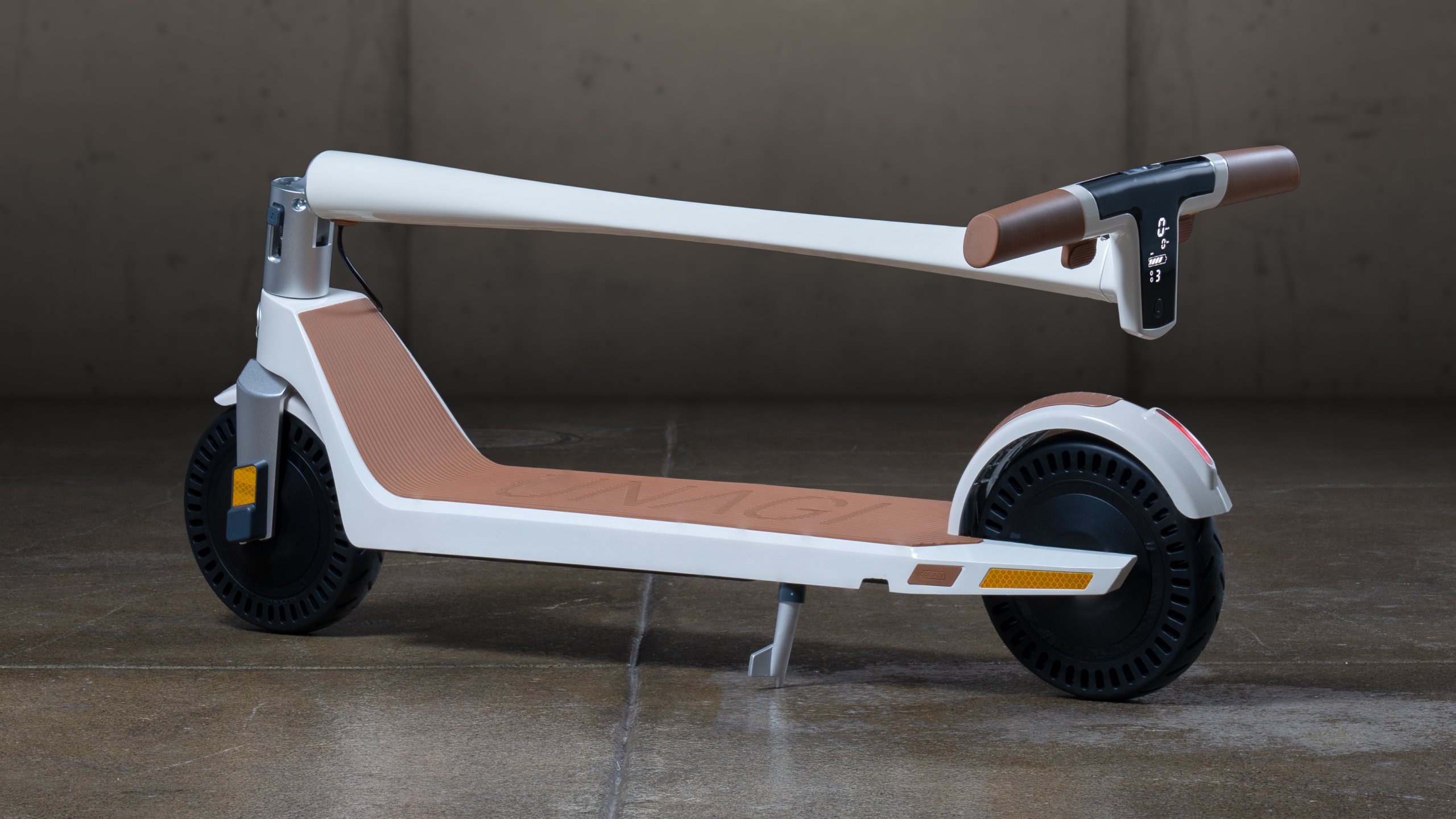
There are a number of lightweight electric scooters on the market you can also look at, but it's really hard to find one that has dual motors. Most lightweight scooters are either single-motor or underpowered, while most dual-motor scooters weigh over 50 lbs, which can be an issue if you use the scooter for daily commutes. Lugging around that much weight on the metro, bus, or stairs can be tedious, even if it's just for a short while.

Stay current with the latest U.S. electric scooter laws in our 2025 guide. Updated annually since our first comprehensive guide, ensuring you have the most recent state and city regulations to ride responsibly”

The Slack Core 920R is currently the fastest electric scooter in 2025 that you can purchase without the need for pre-order.

Our selection of the best electric scooters 2025 spans the fastest e-scooters to the most portable ones, the ones designed for city riding and off-road, the best scooters for rain, budget electric scooters for students, and more powerful ones for skilled riders.

The Unagi Voyager is the best lightweight electric scooter for adults and teenagers. It is the ultraportable sequel to its predecessor, the Unagi Model One Classic.

If you're wondering whether an electric scooter with a seat is right for you, this is a detailed article that would suit your need.

Understand which personal electric vehicle is best, the choice between an electric bike or electric scooter might already be made for you by some critical factors, including portability and storage capacity.

In the U.S., most states don't require a license. For those that do, they usually just ask for a regular driver's license or a learner's permit.

Yes, you can bring an electric scooter on a plane, but it needs to have a lithium battery smaller than 100 watt-hours, which most don't.

Manufacturers advise against riding electric scooters in the rain. The main reasons are: water can fry the electronics, make the ride dangerous, and void your warranty.

The basis and the premise of my work is that we either operate out of love or we operate out of fear...Time is currency. The coolest thing about the scooters is that it's really quick, and it goes uphill. From there, traveling more efficiently and having a good time doing it--I think that's the most important thing.

Cynthia Leu has a full plate. A tech worker by day, Cynthia spends her off time balancing the parallel lives of a powerlifter, entrepreneur, mental health advocate, and more. Riding Unagi helps this USMC veteran cut down on everyday…

https://www.youtube.com/watch?v=7m2hVBE62LY Rasheed Muhammad is sick of Los Angeles traffic. In order to preserve his sanity, Rasheed has traded his everyday driving habit for the portable and beautiful Unagi Model One. It’s an essential accessory for navigating LA streets -- and…

Rich Lee, Co-Founder of San Francisco’s SPRO Coffee Lab, wants to share his love for coffee with the world. He depends on riding Unagi to avoid the hassle of navigating the parking crunch in the booming Mission Bay neighborhood.…















